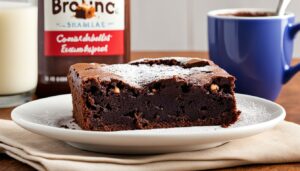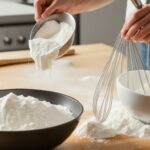Originally posted on December 12, 2023 @ 4:09 am
Have you ever wondered how adding cocoa powder can transform your favorite cookie recipe? Cocoa powder not only adds a delicious chocolatey flavor but also affects the texture and overall outcome of your cookies. Understanding these effects is crucial for creating mouthwatering cocoa-infused treats.
Contents
- 1 Understanding Cocoa Types: Natural vs. Dutch-process
- 2 The Role of Cocoa in Leavening
- 3 Substituting Cocoa Powders in Recipes
- 4 The Impact of Flour in Cocoa Powder Cookies
- 5 The Role of Eggs in Cocoa Powder Cookies
- 6 The Importance of Ratios in Cookie Recipes
- 7 The Influence of Other Factors on Cocoa Powder Cookies
- 8 Choosing the Right Cocoa Powder for Your Cookies
- 9 Conclusion
- 10 FAQ
- 10.1 What changes when I add cocoa powder to a cookie recipe?
- 10.2 What is the difference between natural cocoa powder and Dutch-process cocoa powder?
- 10.3 What leavening agents should I use when baking with cocoa powder?
- 10.4 Can I substitute natural cocoa powder for Dutch-process cocoa powder?
- 10.5 How does the amount of flour affect the texture of cocoa powder cookies?
- 10.6 What role do eggs play in cocoa powder cookies?
- 10.7 How do ingredient ratios affect the outcome of cocoa powder cookies?
- 10.8 What factors besides ingredients affect the outcome of cocoa powder cookies?
- 10.9 How do I choose the right cocoa powder for my cookies?
- 10.10 How does cocoa powder impact cookie recipes overall?
- 11 Source Links
Key Takeaways:
- Adding cocoa powder to a cookie recipe can significantly alter both the texture and flavor.
- There are different types of cocoa powder, including natural and Dutch-process, which have distinct characteristics when used in baking.
- The type of leavening agents and ratios in the recipe should be adjusted according to the type of cocoa powder being used.
- Substituting one type of cocoa powder for another can result in slight differences in color, taste, and overall texture of the cookies.
- Other factors such as the choice of flour, number of eggs, and baking techniques also impact the final outcome of cocoa powder cookies.
Understanding Cocoa Types: Natural vs. Dutch-process
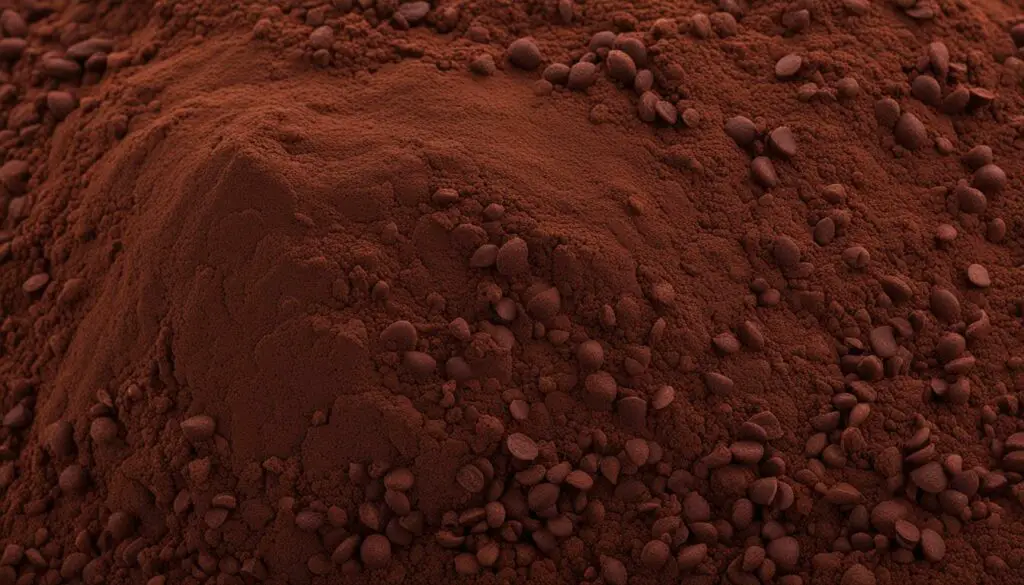
When it comes to cocoa powder, there are two main types: natural and Dutch-process. Understanding the difference between these two varieties is essential for achieving the desired results in your baking endeavors.
Natural cocoa powder is made by grinding roasted cacao beans. It has a lighter color and a more fruity flavor. The natural acidity of this cocoa powder can have a leavening effect in recipes, making it ideal for use with baking soda as a leavening agent.
Dutch-process cocoa powder, on the other hand, undergoes additional processing. It is treated with an alkalizing agent to reduce its acidity. This results in a darker cocoa powder with a milder taste. Dutch-process cocoa powder is often used with baking powder as the leavening agent since its alkalinity doesn’t require the acidity of baking soda.
Here’s a visual comparison of the two types of cocoa powder:
| Natural Cocoa Powder | Dutch-process Cocoa Powder |
|---|---|
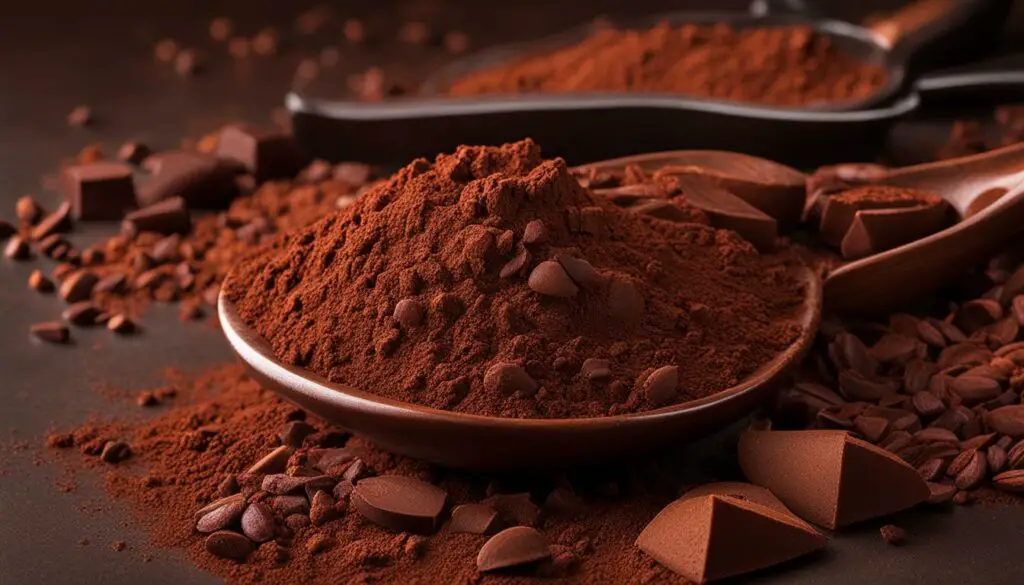
|
As you can see, natural cocoa powder is lighter in color compared to the darker Dutch-process cocoa powder. These visual distinctions offer a glimpse into the differences between these two types of cocoa powder as you prepare to use them in your recipes.
When substituting one type of cocoa powder for the other, it’s important to consider the potential impact on the flavor, color, and leavening properties of your baked goods. Stay tuned as we explore these considerations further in the upcoming sections!
The Role of Cocoa in Leavening
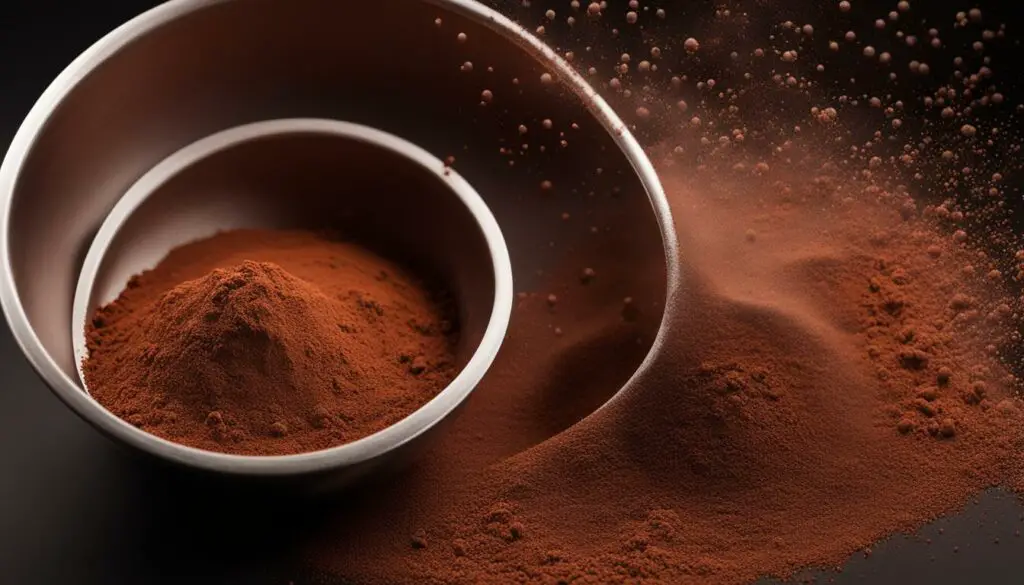
When it comes to baking with cocoa powder, understanding its role in leavening is crucial for achieving the desired results. The type of leavening agent used in a recipe depends on the type of cocoa powder being used. Let’s explore how cocoa powder interacts with leavening agents and how it affects the outcome of your baked goods.
Recipes that call for natural cocoa powder often use baking soda as the leavening agent. This is because the acidity of the cocoa powder helps activate the baking soda, resulting in cookies that rise and spread properly. The cocoa powder and baking soda combination creates a chemical reaction that produces carbon dioxide, causing the dough to rise.
On the other hand, recipes that call for Dutch-process cocoa powder generally use baking powder as the leavening agent. Dutch-process cocoa powder has been treated with an alkalizing agent to reduce its acidity. As a result, it no longer requires the acidity of baking soda to activate the leavening process. Baking powder, which contains both an acid and a base, reacts with the alkalized cocoa powder to produce carbon dioxide, creating the necessary lift in the dough.
Understanding this relationship between cocoa powder and leavening agents is essential for successful baking, as using the wrong leavening agent can result in flat or dense cookies. Below is a simplified table summarizing the use of leavening agents with different types of cocoa powder:
| Cocoa Powder Type | Leavening Agent |
|---|---|
| Natural Cocoa Powder | Baking Soda |
| Dutch-process Cocoa Powder | Baking Powder |
The relationship between cocoa powder and leavening agents is crucial for achieving the desired texture and rise in your baked goods.
Now that you understand the role of cocoa powder in leavening, let’s move on to the next section and explore how to substitute different types of cocoa powder in recipes.
Substituting Cocoa Powders in Recipes
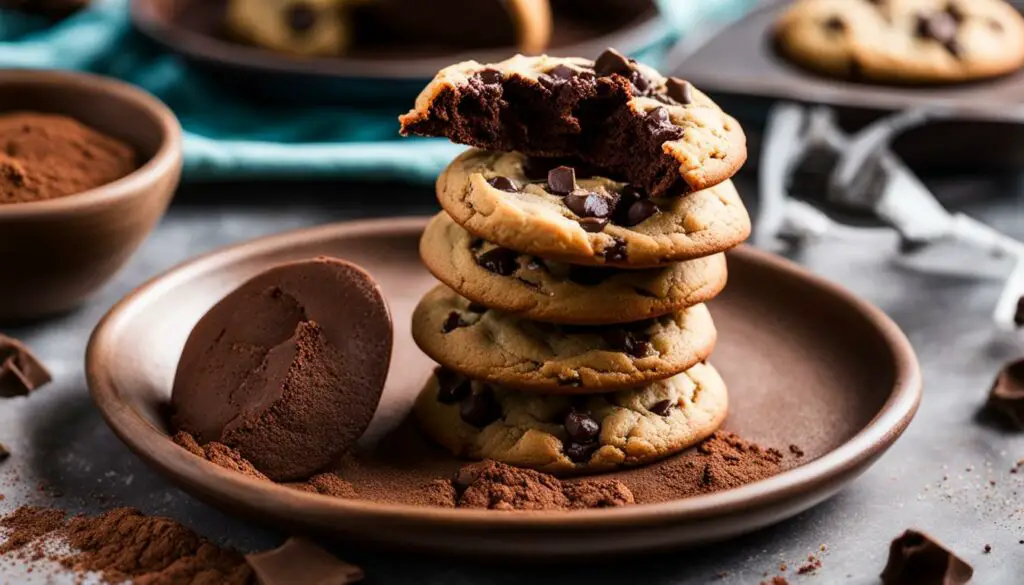
When it comes to cocoa powders, there are two main types: natural cocoa and Dutch-process. While they can be substituted for each other in recipes, it’s important to note that some differences may arise in the final outcome.
Substituting Natural Cocoa for Dutch-Process: If you’re looking to substitute natural cocoa powder for Dutch-process cocoa powder, there are a few factors to consider. The resulting baked goods may be lighter in color compared to using Dutch-process cocoa, and they might also have a slightly tangier or more bitter flavor. However, this substitution can work well in recipes where a more intense cocoa flavor is desired.
Substituting Dutch-Process for Natural Cocoa: On the other hand, if you’re substituting Dutch-process cocoa powder for natural cocoa powder, there are some differences to be aware of. The baked goods may be darker in color compared to using natural cocoa, and the flavor may be more muted. This substitution can be beneficial in recipes where you prefer a milder cocoa flavor.
While substituting cocoa powders, it’s also possible to adjust the recipe to better match the type of cocoa powder being used. One way to do this is by changing the leavening agents. For recipes that originally call for natural cocoa powder and baking soda, you can use Dutch-process cocoa powder and baking powder instead to ensure proper leavening. Similarly, for recipes that call for Dutch-process cocoa powder and baking powder, you can use natural cocoa powder and baking soda.
Before making any substitutions or adjustments, it’s important to consider the overall flavor and color profile you desire in your baked goods. By understanding how different cocoa powders can affect your recipes and making appropriate adjustments, you can create delicious and unique treats.
The Impact of Flour in Cocoa Powder Cookies
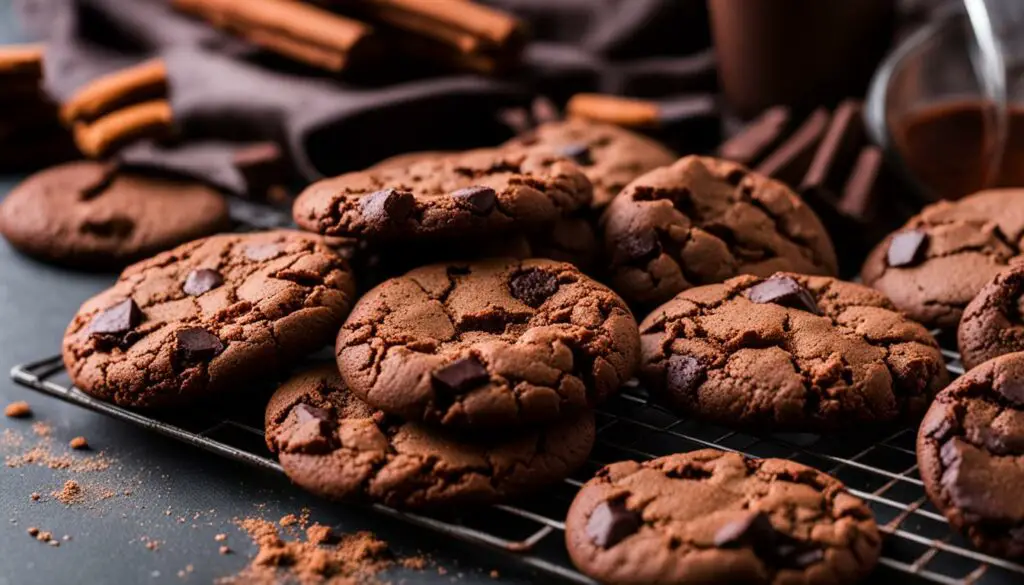
The amount and type of flour used in a cookie recipe can significantly influence the final result. Flour plays a crucial role in determining the texture and spread of cocoa powder cookies. Let’s explore the effects of different types of flour on the outcome of these delicious treats.
When it comes to cocoa powder cookies, the quantity of flour directly affects their texture. Adding more flour to the recipe will result in cookies with a denser and more cake-like texture. These cookies will have less spread and hold their shape well. On the other hand, reducing the amount of flour will yield cookies with a chewier texture and more spread.
However, it’s not just the quantity of flour that matters; the protein content of the flour also has an impact. Higher protein flours, such as bread flour, can produce chewier cookies. The extra gluten formed from the higher protein content results in a more substantial and chewy texture. Conversely, lower protein flours, like cake flour, will create cookies that are lighter and more cake-like in texture.
To summarize, the amount and type of flour used in cocoa powder cookies can significantly alter their texture and spread. Adding more flour will result in cookies that are dense and cake-like, while reducing the flour will yield chewier cookies with more spread. Meanwhile, the protein content of the flour influences the overall texture, with higher protein flours resulting in chewier cookies and lower protein flours producing more cake-like cookies. Adjusting the flour in your cocoa powder cookie recipe allows you to customize the texture and experience of these delightful treats.
| Type of Flour | Texture | Spread |
|---|---|---|
| Bread Flour (high protein) | Chewier | Less spread |
| All-Purpose Flour (medium protein) | Balance between chewy and cake-like | Moderate spread |
| Cake Flour (low protein) | Light and cake-like | More spread |
The Role of Eggs in Cocoa Powder Cookies

Eggs play a crucial role in the structure and texture of cocoa powder cookies. They not only provide structure through their protein content but also contribute moistness to the dough. The number of eggs used in a cookie recipe can significantly impact the final outcome, resulting in cookies with different textures and spreads.
When more eggs are added to a cocoa powder cookie recipe, the cookies tend to have a greater spread and a denser, chewier texture. The additional eggs increase the protein content in the dough, providing more structure and resulting in cookies that hold their shape while baking. These cookies are often favored by those who enjoy a hearty, chewy texture in their cookies.
On the other hand, reducing the number of eggs in a cocoa powder cookie recipe will yield cookies with a cakier texture and less spread. With fewer eggs, the dough becomes lighter and more delicate, resulting in cookies that are softer and have a lighter texture. These cookies are typically enjoyed by those who prefer a lighter, cake-like cookie.
It’s important to note that the presence of egg yolks in a cocoa powder cookie recipe can also affect the flavor and color of the cookies. Egg yolks contribute richness and depth of flavor, as well as a yellow hue to the baked cookies.
Did you know? Incorporating different types of eggs, such as large eggs or extra-large eggs, can also influence the texture and structure of cocoa powder cookies. Experimenting with different egg sizes can be an exciting way to customize your cookies and achieve the desired results.
Overall, understanding the role of eggs in cocoa powder cookies is essential for achieving the desired texture and flavor. Whether you prefer cookies with a chewy, dense texture or a lighter, cakier consistency, adjusting the number of eggs in your recipe can help you achieve the perfect cocoa powder cookie.
The Importance of Ratios in Cookie Recipes

When it comes to baking cookies, the ratios of ingredients in a recipe play a crucial role in determining the final outcome. Changes in these ratios can have a significant impact on the spread, rise, texture, color, and flavor of your cookies. That’s why it’s essential to carefully consider the ratios of ingredients when experimenting with cookie recipes.
The ratios of ingredients in a cookie recipe refer to the proportions of different components such as flour, sugar, butter, eggs, and leavening agents. Each ingredient contributes specific characteristics to the cookie dough, and altering these ratios can result in distinct variations in the final product.
Let’s take a look at how different ingredient ratios can affect your cookies:
- Flour Ratio: The amount of flour used in a cookie recipe can impact the texture and spread of the cookies. More flour will yield cookies that are firmer and have less spread, resulting in a denser texture. On the other hand, less flour will produce cookies that are softer and have more spread, leading to a chewier texture.
- Sugar Ratio: The ratio of sugar in a cookie recipe determines its sweetness and texture. More sugar will make the cookies sweeter and contribute to a crispier texture, creating a caramelized exterior. Conversely, less sugar will yield cookies with a milder sweetness and a softer, chewier texture.
- Butter Ratio: The ratio of butter in a cookie recipe influences its richness, moisture, and flavor. More butter will result in cookies with a richer taste and a softer, melt-in-your-mouth texture. Using less butter will yield cookies that are drier and have a crumblier texture.
- Egg Ratio: The number of eggs used in a cookie recipe affects the structure and moisture content of the cookies. More eggs will contribute to a denser texture and more spread in the cookies. Conversely, fewer eggs will result in a lighter, cakier texture with less spread.
- Leavening Agent Ratio: The ratio of leavening agents, such as baking soda or baking powder, can impact the rise and texture of the cookies. Using more leavening agents will create cookies with a higher rise and a lighter, more cake-like texture. Using less leavening agents will result in cookies that are denser and have less volume.
By understanding the impact of ingredient ratios in cookies, you can tailor your recipes to achieve your desired texture, flavor, and appearance. Whether you’re looking for a crisp and buttery cookie or a chewy and soft indulgence, experimenting with different ratios will help you find the perfect balance.
To illustrate the significance of ingredient ratios, let’s take a look at the following table:
| Ingredient | Ratio | Resulting Outcome |
|---|---|---|
| More Flour | Increased | Firmer texture and less spread |
| Less Flour | Decreased | Softer texture and more spread |
| More Sugar | Increased | Sweeter taste and crispier texture |
| Less Sugar | Decreased | Milder sweetness and chewier texture |
| More Butter | Increased | Richer flavor and softer texture |
| Less Butter | Decreased | Drier texture and crumbly consistency |
| More Eggs | Increased | Denser texture and more spread |
| Less Eggs | Decreased | Lighter, cakier texture with less spread |
| More Leavening Agent | Increased | Higher rise and lighter, cake-like texture |
| Less Leavening Agent | Decreased | Denser texture and less volume |
As you can see, even small adjustments in ingredient ratios can lead to significant differences in the cookies you bake. So, next time you’re experimenting in the kitchen, don’t forget to consider the ratios of your cookie recipe ingredients.
The Influence of Other Factors on Cocoa Powder Cookies
While the type of cocoa powder and the ratios of ingredients are crucial, there are several other factors that can significantly affect the outcome of your cocoa powder cookies. These factors include the baking setup, resting times, and mixing times, which all play a role in the final texture and flavor of your delicious treats.
Baking Setup: The type of baking surface used can have an impact on the cookies. For instance, using parchment paper can result in cookies with a slightly crisper exterior, while a silicone baking mat can yield cookies that are softer and chewier.
Resting Times: Allowing the dough to rest before baking can contribute to the texture and structure of the cookies. Resting the dough for a longer period can lead to cookies that are thicker and have a more pronounced flavor. On the other hand, shorter resting times can produce cookies that spread more and are lighter in texture.
Mixing Times: The duration of mixing the cookie dough can impact the final texture. Overmixing can result in cookies that are tougher and denser, while undermixing can lead to cookies that are more tender but may lack structure. It’s important to find the right balance when mixing the dough to achieve the desired texture.
Incorporating these factors into your baking routine can help you fine-tune your cocoa powder cookies and create the perfect balance of texture and flavor. Remember to experiment and adjust these factors according to your personal preferences and desired outcome.
Now that we’ve explored the various factors that can influence the outcome of cocoa powder cookies, let’s move on to discussing the importance of choosing the right cocoa powder for your recipes.
Choosing the Right Cocoa Powder for Your Cookies
When it comes to baking cookies, choosing the right cocoa powder can make a significant difference in the flavor, color, and overall texture of your sweet treats. With so many options available, it’s important to consider your preferences and the desired outcome. Let’s explore the different factors to keep in mind when selecting cocoa powder for your cookie recipes.
Natural Cocoa Powder for Light and Fruity Flavor
If you’re aiming for a lighter and fruitier flavor profile in your cookies, natural cocoa powder is an excellent choice. Made by grinding roasted cacao beans, this type of cocoa powder adds a delightful tanginess and a vibrant aroma to your baked goods. It’s perfect for those who enjoy a classic, slightly acidic taste in their cookies.
Dutch-Process Cocoa Powder for Richness and Mildness
On the other hand, if you prefer a richer and milder taste in your cookies, Dutch-process cocoa powder is the way to go. This cocoa powder undergoes an alkalizing process that reduces its acidity, resulting in a smoother and mellower flavor. Dutch-process cocoa powder creates deep, dark-colored cookies with a luxurious chocolate taste.
The Impact of Fat Content on Your Cookies
In addition to considering the flavor profile, the fat content of the cocoa powder can also influence the texture and moisture of your cookies. Opting for a high-fat cocoa powder can lead to cookies that are more flavorful, indulgent, and moist. The increased fat content adds richness and depth to the overall taste. It’s worth noting that a higher fat content may require some adjustments to other ingredients, such as reducing the amount of butter or oil in your recipe.
Using High-Quality Cocoa Powder for the Best Results
When it comes to achieving the best possible outcome, using high-quality cocoa powder is crucial. Look for reputable brands that prioritize the finest cocoa beans and sustainable sourcing practices. High-quality cocoa powder is often more aromatic, flavorful, and delivers superior results in your cookies.
To summarize, choosing the right cocoa powder for your cookies involves considering the desired flavor, color, and texture. Natural cocoa powder offers a lighter and fruitier taste, while Dutch-process cocoa powder provides a richer and milder experience. Opting for cocoa powder with a higher fat content can result in more flavorful and moist cookies. Finally, using high-quality cocoa powder ensures the best outcome for your baking endeavors.
Conclusion
In conclusion, the addition of cocoa powder to a cookie recipe can have a significant impact on the texture and flavor of the cookies. By understanding the differences between natural and Dutch-process cocoa powder, as well as the role of other ingredients, ratios, and factors, you can achieve the desired outcome in your cookie recipes.
Experimenting with different types of cocoa powder allows you to create delicious and unique cookies. Whether you prefer the lighter and fruitier flavor of natural cocoa powder or the richer and milder taste of Dutch-process cocoa powder, selecting the right cocoa powder is crucial. Additionally, choosing a cocoa powder with a higher fat content can result in more flavorful and moist cookies.
Enjoy the process of baking and exploring the world of cocoa powder in cookies. With the knowledge gained from this article, you can confidently venture into creating your own cocoa powder cookie recipes and impress your friends and family with your baking skills. Happy baking!
FAQ
Adding cocoa powder to a cookie recipe can impact both the texture and flavor of the cookies.
What is the difference between natural cocoa powder and Dutch-process cocoa powder?
Natural cocoa powder is made from roasted cacao beans and has a lighter color and fruity flavor. Dutch-process cocoa powder is treated with an alkalizing agent, resulting in a darker color and milder taste.
What leavening agents should I use when baking with cocoa powder?
Recipes with natural cocoa powder typically use baking soda, while those with Dutch-process cocoa powder use baking powder.
Can I substitute natural cocoa powder for Dutch-process cocoa powder?
Yes, but there may be differences in color and flavor. Adjusting the recipe and using the appropriate leavening agent can help achieve desired results.
More flour yields cookies with less spread and a cake-like texture, while less flour results in more spread and a chewier texture.
Eggs provide structure and moisture to the dough. More eggs create denser, chewier cookies, while fewer eggs result in cakier cookies with less spread.
Changes in ingredient ratios can impact the spread, rise, texture, color, and flavor of the cookies.
Factors such as baking setup, resting times, and mixing times can also impact the texture and flavor of the cookies.
Consider the desired flavor, color, and texture. Natural cocoa powder has a lighter, fruitier flavor, while Dutch-process cocoa powder offers a richer taste. Higher-fat cocoa powder can result in more flavorful cookies.
Adding cocoa powder to cookie recipes can create unique flavors and textures. Understanding the different types of cocoa powder and adjusting recipes accordingly can lead to delicious results.




